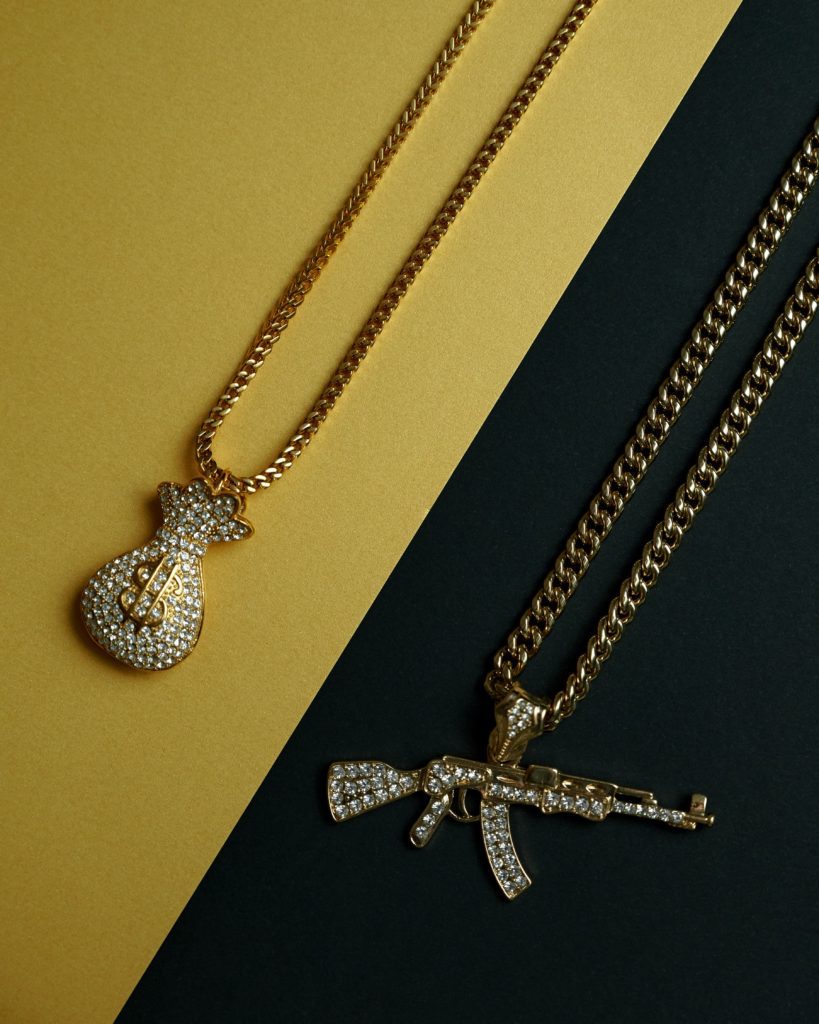A gold chain is a must-have timeless piece of jewelry regularly worn by both men and women for many occasions. Many people pay high prices for real gold chains for many reasons, including the items lasting longer, retaining more value as an investment, and often as a flex or symbol of wealth.
The ancient Egyptians believed gold was the flesh of the sun god Ra. Gold is considered luxurious and precious because it is beautiful and easy to work with. It does not tarnish, rust, or dissolve (except by aqua regia, the name for nitrohydrochloric acid, which is used in one of the tests mentioned below). Gold is hard to extract: Barely 50 grams come out of a ton of ore. It is also one of the best electrical conductors, which is why it is used so heavily inside computers and other technological equipment.
First we recommend reading about the different types of gold jewelry offered by sellers. Read more here.
What Is Real Gold?
There are pros and cons to all types of metals, but Solid Gold is generally the more superior metal because it’s the most durable, valuable, and least irritating to those that have allergies to base metals. However, Solid Gold will be more expensive than plated or filled metals.
Gold Plated pieces are a more affordable alternative; however, they only contain a tiny amount of gold, and any friction will cause the plating to rub off quickly, leaving a dull piece of metal. Most base metals used in Gold Plated jewelry also tend to stain your skin green or cause allergic reactions. Gold Plated jewelry is only suitable for fashion jewelry, and requires more care and maintenance, as exposure to small amounts of moisture, sweat and lotions will degrade the piece rapidly. Regular re-plating is also required to restore pieces back to their original condition, resulting in added ongoing expenses.
Gold Filled pieces are also a more affordable alternative to Solid Gold, however, over time they will also degrade, lose their color, and are difficult to restore.
With more affordable alternatives in lower carat gold (e.g. 9k gold), Solid Gold pieces will:
- Always be valuable
- Last longer and require less maintenance
- Encourage sustainability due to the longer wearing nature of fine jewelry pieces
There are many suppliers and sources that sell ingenuine gold for high prices, making it very important for buyers to know how to identify if the gold is real. So how do you tell whether a gold chain is real or fake? This article is going to provide some tips on how you can determine before buying.
Looking to sell your gold chain? Contact us Today for a free consultation.
Look at the Marking on your Gold Chain
A piece of gold jewelry is often engraved with a hallmark, which is a stamp that identifies its content and/or manufacturer. Hallmarks usually appear in an inconspicuous place like the inside of a ring.
The standard purity scales are based upon karats and millesimal fineness. The hallmark test is a good place to start when checking if your gold is real.
Hallmarks include:
- Purity numbers under the Karat system (like 8k, 9k, 10k, 14k, 15k, 18k, 20k, 21k, 22k, 23k, and 24k)
- Purity numbers under the Millesimal Fineness system (333, 375, 417, 583 or 585, 625, 750, 833, 875, 916, 958 and 999)
- False purity numbers (anything other than the above)
- Manufacturer (like ESPO for Esposito, etc.)
Hallmarks show the gold’s level of purity and manufacturer to lend greater credibility to a piece’s authenticity and to make it easier to identify and verify. Since anybody can engrave any hallmark they choose, this level of testing is not 100% foolproof
If the numbers say anything other than the ones mentioned above, then you have fake gold. For example, 800, 925, and 950 do not refer to gold, but to silver. Why would they be put 925 on gold? Because this often means the jewelry is gold plated with a sterling silver base.
Anyone who is familiar with the different levels of quality will quickly recognize the following markings:
- GP – Gold Plated
- GF – Gold Filled
- GE – Gold Electroplated
- GEP Gold Electro Plated
- HGP – Heavy Gold Plated
- HEG – Heavy Gold Electroplated
These markings indicate that only a small percentage of gold was used to cover a piece that was made from some other kind of metal to give it the appearance of gold.
To give you an idea of how the upper levels of purity stack up next to one another: 24k gold is 99.9% pure, while 18k gold is 75% pure. Absolutely 100% pure gold is unheard of, mainly because pure gold is very soft and wouldn’t make for a durable piece of jewelry.
Want more info on how gold is priced and evaluated? Check out our other article, How the Market Price for Gold is Determined
Test Your Gold Chain on Skin
This test is simple: It involves holding a piece of gold jewelry between your hands for a couple of minutes. The perspiration from your hands will either react with the metal and change the color of your skin or leave it unaffected. When real gold is in direct contact with your skin there is no discoloration. If the gold is fake, it will cause your skin to turn black, blue, or green at the contact points.
One exception to this procedure occurs if you test gold on your skin while wearing a liquid foundation. When gold touches the makeup, it will turn your skin black at the points of contact. Removing all makeup before testing makes this test more reliable.
Alternatively, makeup can also be used to test for gold authenticity. Put on a liquid foundation and add powder over it. Once the makeup has dried, press the piece of jewelry against your skin and then run it lightly over your skin where you have the makeup. If the jewelry leaves a black track on the makeup, you probably have real gold.
Gold is extremely nonreactive, so real gold jewelry will never discolor your skin. But using the makeup test is a unique way to also check if it’s real.
If there are discolorations in gold jewelry it means you have an alloy where there are other metals mixed in.
The Magnet Test
Hold a strong magnet next to a piece of gold and watch for a reaction. Gold is not magnetic, so there should not be any attraction to magnets. If there is, you most likely don’t have real gold.
However, some of the base metals that can be mixed with gold are also non-magnetic so you can get a false read. The test isn’t foolproof so it’s a good idea to do this in conjunction with another more accurate testing method.
The Float Test
Just drop the piece into a container of water. Gold is dense. If it doesn’t float at all or hover over the bottom of the container, you could possibly have real gold.
The White Vinegar Test
This test simply requires that a few drops of vinegar be applied to the metal, hopefully in an inconspicuous place.
If the metal is real gold, there will be no change. If the metal is fake gold, it will change color.
Go to An Appraisal Professional
If you really want to know for sure how much gold is really in your gold, the most tried-and-true method of finding out is to take it to a reputable jeweler and have it tested there.
Jewelers have a wide array of methods available to the public for authentication of gold content. Of course, nothing beats experience. But those who are trying to pass lesser metals off as real gold have become increasingly sophisticated in their “craft,” so even the jeweler will probably resort to machine verification to make sure.
The best way to know for sure if your gold is real is to have an experienced and reputable jeweler evaluate it for you.
Looking to sell your gold? Find out how much it is worth and Contact Us Today for a free consultation.
Photo by Maxim Lugovnin on Unsplash




